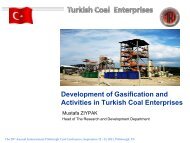Abstract Booklet 2006 - Swanson School of Engineering - University ...
Abstract Booklet 2006 - Swanson School of Engineering - University ...
Abstract Booklet 2006 - Swanson School of Engineering - University ...
Create successful ePaper yourself
Turn your PDF publications into a flip-book with our unique Google optimized e-Paper software.
solid sorbents; and separation by membranes. In one concept, a wet scrubbing<br />
technique is being investigated that uses a physical solvent process to remove CO 2<br />
from fuel gas <strong>of</strong> an IGCC system at elevated temperature and pressure. The need to<br />
define an ideal solvent has led to the study <strong>of</strong> the solubility and mass transfer<br />
properties <strong>of</strong> various solvents. Fabrication techniques and mechanistic studies for<br />
hybrid membranes separating CO 2 from the fuel gas produced by coal gasification are<br />
also being performed. Membranes that consist <strong>of</strong> CO 2 -philic silanes incorporated into<br />
an alumina support or ionic liquids encapsulated into a polymeric substrate have been<br />
investigated for permeability and selectivity. An overview <strong>of</strong> two novel techniques is<br />
presented along with a research progress status <strong>of</strong> each technology.<br />
P2-2<br />
Selective Catalytic Oxidation <strong>of</strong> Hydrogen Sulfide -<br />
Systems Analysis for IGCC Application<br />
Richard A. Newby, Dale L. Keairns, Science Applications International Corporation,<br />
USA<br />
Maryanne Alvin, DOE/NETL, USA<br />
Selective catalytic oxidation <strong>of</strong> hydrogen sulfide (SCOHS) has been evaluated<br />
conceptually for IGCC applications, and the theoretical limits <strong>of</strong> reaction performance,<br />
process performance, and economic potential in IGCC have been estimated. Syngas<br />
conditions that have high partial pressures <strong>of</strong> total sulfur result in substantial liquid<br />
sulfur retention within the catalyst bed, with relatively complex processing being<br />
required. Applications that have much lower total sulfur partial pressure in the process<br />
gas might permit SCOHS operation under conditions where little liquid sulfur is<br />
retained in the catalyst, reducing the processing complexity and possibly improving the<br />
desulfurization performance. The results from our recent IGCC process evaluations<br />
using the SCOHS technology and conventional syngas cleaning are presented, and<br />
alternative SCOHS process configurations and applications that provide greater<br />
performance and cost potential are identified.<br />
P2-3<br />
Optimization <strong>of</strong> Heat Recovery Steam Generators for IGCC Power Plants<br />
D. N. Reddy, Osmania <strong>University</strong>, INDIA<br />
Basic human needs can be met only through industrial growth, which depends to a<br />
great extent on energy supply. The large increase in population during the last few<br />
decades and the spun in industrial growth have placed tremendous burden on the<br />
electrical utility industry and process plants producing chemicals, fertilizers,<br />
petrochemicals, and other essential commodities, resulting in the need for additional<br />
capacity in the areas <strong>of</strong> power and steam generation throughout the world. Steam is<br />
used in nearly every industry; and it is well known fact that steam generators and heat<br />
recovery boilers are vital to power and process plants. It is no wonder that with rising<br />
fuel and energy costs engineers in these, fields are working on innovative methods to<br />
generate electricity, improve energy utilization in these plants, recover energy<br />
efficiently, from various waste gas sources, and simultaneously minimize the impact<br />
these processes have on environmental pollution and the emission <strong>of</strong> harmful gases to<br />
the atmosphere. Heat recovery boilers, also known as waste heat recovery boilers or<br />
heat recovery steam generators (HRSGs), form an inevitable part <strong>of</strong> chemical plants,<br />
refineries, power plants, and process systems. They are classified in several ways,<br />
according to the application, the type <strong>of</strong> boiler used, whether the line gas is used for<br />
process or mainly for energy recovery, cleanliness <strong>of</strong> the gas, and boiler configuration,<br />
to mention a few. The main clarification is based on whether the boiler is used for<br />
process purposes or for energy recovery. Process waste heat boilers are used to cool<br />
waste gas streams from a given inlet temperature to a desired exit temperature for<br />
further processing purposes. An example can be found in the chemical industry in a<br />
sulfuric acid or hydrogen plant- where the gas steam is cooled to a particular gas<br />
temperature and then taken to a reactor for further processing. The exit gas temperature<br />
from the boiler is an important parameter affecting the downstream process reactions<br />
and hence is controlled by using a gas bypass system. Steam generation is <strong>of</strong> secondary<br />
importance in such plants. In energy recovery applications, on the other hand, the gas<br />
is cooled as much as possible while avoiding low temperature corrosion and steam<br />
generation throughout the world. Steam is used in nearly every industry; and it is well<br />
known that steam generators and heat recovery boilers are vital to power and process<br />
plants. It is no wonder that with rising fuel and energy cost engineers in these, fields<br />
are working on innovative methods to generate electricity, improve energy utilization<br />
in these plants, recover energy efficiently, from various waste gas sources, and<br />
simultaneously minimize the impact these processes have on environmental pollution<br />
and the emission <strong>of</strong> harmful gases to the atmosphere.<br />
P2-4<br />
Thermogravimetric characteristics and kinetic <strong>of</strong> coal/plastic blends co-pyrolysis<br />
Limin Zhou, Yipin Wang, Qunwu Huang, Junqing Cai, Tianjin <strong>University</strong>, CHINA<br />
Co-pyrolytic behaviours <strong>of</strong> different plastics(high density polyethylene, low density<br />
polyethylene and polypropylene) and low volatile coal (LVC) were investigated using<br />
TGA. The results indicated that coal was decomposed at in the temperature range 174-<br />
710°C, while the thermal degradation temperature <strong>of</strong> plastic is 438-521°C. Plastics<br />
showed similar pyrolysis behaviors due to similar chemical bonds in their molecular<br />
structures. The overlapping degradation temperature interval between coal and plastic<br />
is beneficial to hydrogen transfer from plastic to coal. The difference <strong>of</strong> weight loss<br />
(ΔW) between experimental and theoretical ones, calculated as a algebraic sums <strong>of</strong><br />
those from each separated component, is about 5-6% at 550-650°C. These<br />
experimental results indicate on significant synergistic effect during plastic and<br />
biomass co-pyrolysis at the high temperature region. In addition, a kinetic analysis was<br />
performed to fit thermogavimetric data, the global processes being considered as one<br />
to three consecutive first order reactions. A reasonable fit to the experimental data was<br />
obtained for all materials and their blends.<br />
P2-5<br />
Solvent Extraction <strong>of</strong> South African Coal-A Review<br />
Johan van Dyk, TJ van de Walt, Sasol Technology, SOUTH AFRICA<br />
Sasol’s Secunda plants in South Africa are very conveniently placed with respect to the<br />
vast coal reserves <strong>of</strong> the Mpumulanga region. Sasol converts these coal reserves, via its<br />
indirect liquefaction process, into liquid fuels and various chemicals. This process is<br />
operated under severe process conditions, and the concomitant release <strong>of</strong> big volumes<br />
<strong>of</strong> CO 2 presents environmental problems. In addition to this, these plants consume<br />
utilities other than coal (such as water) and need the support <strong>of</strong> a well developed<br />
infrastructure (like e.g. a good roads network). Other, more remote (with respect to the<br />
Secunda plants) coal reserves may be in need <strong>of</strong> a different kind <strong>of</strong> coal conversion<br />
technology before these can be monetised. Such is the case for the Waterberg coal<br />
reserves – coal that is high in vitrinite content and may be eminently suitable for<br />
conversion via coal solvent extraction. The coal solvent extraction process is mild<br />
(with respect to process conditions) and CO 2 release is low; coal is the major utility<br />
consumed in light <strong>of</strong> the process being self-sustainable in terms <strong>of</strong> the solvent that is<br />
required. The product from solvent extraction (mild coal dissolution) is a lowash and<br />
low-sulphur solid or pitch and is suitable for use as a fuel in new technology power<br />
generation plants, or as a reductant in the metallurgical industry, and even as a<br />
precursor for several carbon products. Coal solvent extraction is a well known<br />
technology and the majority <strong>of</strong> literature is based on vitrinite rich coal. Little work is<br />
reported on the mild solvent extraction <strong>of</strong> inertinite rich coals, or the role <strong>of</strong> other<br />
reactive macerals (besides vitrinite). Thus, work on South African coal, also rich in<br />
other reactive macerals, is reviewed.<br />
P2-6<br />
Regenerable Sorbent Development for Sulfur and Chloride<br />
Removal From Coal-Derived Synthesis Gas<br />
Ranjani Siriwardane, DOE/NETL, USA<br />
Thomas Webster, Research Development Solutions, USA<br />
A large number <strong>of</strong> components in coal form corrosive and toxic compounds during<br />
gasification processes. According to the U.S. Department <strong>of</strong> Energy, National Energy<br />
Technology Laboratory (DOE NETL) goals, contaminants have to be reduced to parts<br />
per billion in order to utilize gasification gas streams in fuel cell applications. Even<br />
more stringent requirements are expected if the fuel is to be utilized in chemical<br />
production applications. Regenerable hydrogen sulfide removal sorbents have been<br />
developed at DOE NETL. These sorbents can remove the hydrogen sulfide to parts per<br />
billion range at 316°C and at 20 atmospheres. The sorbent can be regenerated with<br />
oxygen. Reactivity and physical durability <strong>of</strong> the sorbent did not change during the<br />
multi-cycle tests. Results <strong>of</strong> the multi-cycle, benchscale tests utilizing simulated coal<br />
gas and results <strong>of</strong> the tests with real coal gas will be discussed in the paper.<br />
Regenerable hydrogen chloride removal sorbents have also been developed at DOE<br />
NETL. These sorbents can remove HCl to parts per billion range at 300°C to 500°C.<br />
The sorbent can be regenerated with oxygen. Results <strong>of</strong> thermogravimetric analysis<br />
and bench-scale flow reactor tests with both regenerable and non-regenerable HCl<br />
removal sorbents will be discussed in the paper.<br />
P2-7<br />
Assessment and Environmental Performance <strong>of</strong> Coal and Biomass<br />
Based Combined Heat and Power Plants (CHP)<br />
D.N. Reddy, K. Basu, Osmania <strong>University</strong>, INDIA<br />
Shortage and quality <strong>of</strong> grid power prompted Indian Industries to go for captive power<br />
plants. For process industries, uninterrupted steam supply becomes a necessity.<br />
Generally, coal based captive power plants are employed for these duties. These plants<br />
have efficiency range between 5% to 10%. Biomass based Combined Heat and Power<br />
plant (CHP) could improve both generation efficiency and environmental performance.<br />
Biomass based power generation using reciprocating engine is well established<br />
technology. However, low life expectancy and higher cost <strong>of</strong> generation slowed down<br />
the wider adaptation <strong>of</strong> this technology. Gas turbine manufacturers are pursuing<br />
development <strong>of</strong> burning Low Btu gas in combustor. Biomass gasifier integrated to gas<br />
turbine as topping cycle and steam Turbine as bottoming cycle could provide power<br />
cycle efficiency <strong>of</strong> 2% to 4% higher than that <strong>of</strong> conventional power plant. Centre for<br />
Energy Technology carried out designs <strong>of</strong> a CHP plant utilizing the existing<br />
equipment. In spite <strong>of</strong> limitation on component efficiency, power block can attain a net<br />
thermal efficiency <strong>of</strong> 9.9 and CHP efficiency <strong>of</strong> 49.79 for a plant capacity <strong>of</strong> 51.72<br />
kWe. The validation <strong>of</strong> the mathematical models was carried out by using<br />
50














